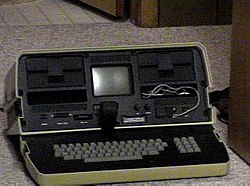
----
Send treats to the troops...
Great because you did it!
www.AnySoldier.com
Posted on 06/09/2008 3:01:55 PM PDT by Berlin_Freeper

Calculations, games, hhmmmmm, Las Vegas?
http://news.cnet.com/8301-10787_3-9945710-60.html?part=rss&subj=news&tag=2547-1_3-0-5
There was a recent article that basically stated that an industrious venture capitalist could profile you and do carefully targeted marketing, depending on your web habits, and this might a ubiquitous process in the future...
“Before it is placed in a classified environment, it will also be used to explore scientific problems like climate change.”
After that, can we have it compute how many pictures exist of Hillary Clinton with her pie hole wide open?
Roadrunner: 130,536 cores break the Petaflop barrier
(the world’s first hybrid supercomputer)
TgDaily | Monday, June 09, 2008 12:13 | Wolfgang Gruener
Posted on 06/09/2008 11:50:57 AM PDT by Ernest_at_the_Beach
http://www.freerepublic.com/focus/chat/2028425/posts
***********************EXCERPT*******************
Cell is a microprocessor architecture jointly developed by Sony Computer Entertainment, Toshiba, and IBM, an alliance known as "STI". The architectural design and first implementation were carried out at the STI Design Center in Austin, Texas over a four-year period beginning March 2001 on a budget reported by IBM as approaching US$400 million.[1] Cell is shorthand for Cell Broadband Engine Architecture, commonly abbreviated CBEA in full or Cell BE in part. Cell combines a general-purpose Power Architecture core of modest performance with streamlined coprocessing elements[2] which greatly accelerate multimedia and vector processing applications, as well as many other forms of dedicated computation.[2]
The first major commercial application of Cell was in Sony's PlayStation 3 game console. Mercury Computer Systems has a dual Cell server, a dual Cell blade configuration, a rugged computer, and a PCI Express accelerator board available in different stages of production. Toshiba has announced plans to incorporate Cell in high definition television sets. Exotic features such as the XDR memory subsystem and coherent Element Interconnect Bus (EIB) interconnect[3] appear to position Cell for future applications in the supercomputing space to exploit the Cell processor's prowess in floating point kernels. IBM has announced plans to incorporate Cell processors as add-on cards into IBM System z9 mainframes, to enable them to be used as servers for MMORPGs[4].
The Cell architecture includes a novel memory coherence architecture for which IBM received many patents. The architecture emphasizes efficiency/watt, prioritizes bandwidth over latency, and favors peak computational throughput over simplicity of program code. For these reasons, Cell is widely regarded as a challenging environment for software development.[5] IBM provides a comprehensive Linux-based Cell development platform to assist developers in confronting these challenges.[6] Software adoption remains a key issue in whether Cell ultimately delivers on its performance potential. Despite those challenges, research has indicated that Cell excels at several types of scientific computation.[7]
In November 2006, David A. Bader at Georgia Tech was selected by Sony, Toshiba, and IBM from more than a dozen universities to direct the first STI Center of Competence for the Cell Processor.[8][9][10] This partnership is designed to build a community of programmers and broaden industry support for the Cell processor.[8][9] There is a Cell Programming tutorial video available.[11]
*****************************snip*************************
PowerXCell 8i Variant
In 2008, IBM announced a revised variant of the Cell called the PowerXCell 8i, which is available in QS22 Blade Servers from IBM. The PowerXCell is manufactured on a 65 nm process, and adds support for DDR2 memory, as well as dramatically improving double-precision floating-point performance on the SPEs from a peak of about 14 GFLOPS to 102 GFLOPS total for 8 SPEs. The IBM Roadrunner supercomputer, currently the world's fastest, consists of nearly 13000 PowerXCell 8i processors, along with almost 7000 AMD Opteron processors.[23]
In some ways the Cell system resembles early Seymour Cray designs in reverse. The famed CDC 6600 used a single very fast processor to handle the mathematical calculations, while a series of ten slower systems were given smaller programs to keep the main memory fed with data. In the Cell the problem has been reversed: reading the data is no longer the difficult problem due to the complex encodings used in industry; today the problem is efficiently decoding that data into an ever-less-compressed version as quickly as possible.
A more recent equivalent is the Parallax Propeller, which has eight "cog" processors controlled by a single "hub"; however this is designed more for flexibility and low chipcount in embedded situations than for high performance.
Modern graphics cards have multiple elements very similar to the SPEs, known as shader units, with an attached high speed memory. Programs, known as shaders, are loaded onto the units to process the input data streams fed from the previous stages (possibly the CPU), according to the required operations.
The main differences are that the Cell's SPEs are much more general purpose than shader units, and the ability to chain the SPEs under program control offers considerably more flexibility, allowing the Cell to handle graphics, sound, or any other workload.
Disclaimer: Opinions posted on Free Republic are those of the individual posters and do not necessarily represent the opinion of Free Republic or its management. All materials posted herein are protected by copyright law and the exemption for fair use of copyrighted works.